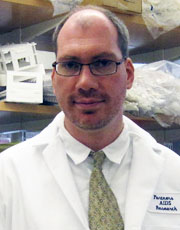 Dr. Timothy Henrich Writing in the October issue of The Journal of Infectious Diseases, amfAR grantee Dr. Timothy Henrich and colleague Dr. Rajesh Gandhi, both of Harvard Medical School, review some exciting observations concerning the impact of initiating antiretroviral therapy (ART) very early after HIV infection. Such intervention appears to limit the seeding of viral reservoirs—a major impediment to curing HIV—and dampens T cell activation—a major source of HIV morbidity. As the authors note, “these provocative reports…have invigorated the field of HIV-1 curative strategies.”
Dr. Timothy Henrich Writing in the October issue of The Journal of Infectious Diseases, amfAR grantee Dr. Timothy Henrich and colleague Dr. Rajesh Gandhi, both of Harvard Medical School, review some exciting observations concerning the impact of initiating antiretroviral therapy (ART) very early after HIV infection. Such intervention appears to limit the seeding of viral reservoirs—a major impediment to curing HIV—and dampens T cell activation—a major source of HIV morbidity. As the authors note, “these provocative reports…have invigorated the field of HIV-1 curative strategies.”
Starting ART within six months of infection limited several measures of deleterious T cell and macrophage immune activation and inflammation. Early treatment also lowered cellular HIV reservoir size. .JPG) Dr. Steven DeeksIt led to skewing the kinds of T cells able to set up a latent reservoir, favoring shorter-lived immune cells.
Dr. Steven DeeksIt led to skewing the kinds of T cells able to set up a latent reservoir, favoring shorter-lived immune cells.
Drs. Henrich and Gandhi close by reviewing a study that shows that the size and distribution of the viral reservoir in tissue cells is not always accurately reflected by blood-based measurements. This finding further emphasizes the need to study HIV not only in the blood, but in tissues as well—particularly the intestines, where HIV persists and needs to be targeted.  Dr. Sarah PalmerThey conclude that, “Although the road ahead is likely to be full of twists and turns, what is certain is that pathogenesis-based investigations…will improve the conception, implementation, and targeting of novel strategies designed to eradicate HIV-1.”
Dr. Sarah PalmerThey conclude that, “Although the road ahead is likely to be full of twists and turns, what is certain is that pathogenesis-based investigations…will improve the conception, implementation, and targeting of novel strategies designed to eradicate HIV-1.”
To further elucidate the benefits of ART, another group of researchers, including amfAR grantees Drs. Steven Deeks of the University of California, San Francisco; Sarah Palmer of the Karolinska Institutet in Stockholm, Sweden; and Una O’Doherty of the University of Pennsylvania, studied the effects of antiretroviral therapy on a very unique group known as “elite controllers.” These rare individuals are HIV positive but are naturally able to maintain low levels of the virus in the absence of ART..jpg) Dr. Una O’Doherty Previous studies by the group had shown that controllers had disproportionately high levels of immune activation, which could lead to increased risk of AIDS- and non-AIDS-related health problems, and may play a role in maintaining the viral reservoir.
Dr. Una O’Doherty Previous studies by the group had shown that controllers had disproportionately high levels of immune activation, which could lead to increased risk of AIDS- and non-AIDS-related health problems, and may play a role in maintaining the viral reservoir.
Reporting in the journal PLOS Pathogens, the research team found that administering ART to elite controllers led to a further decrease in already very low viral levels in both blood and tissues, and limited the amount of immune activation/inflammation. In light of their findings, that a controller’s ability to maintain low levels of HIV may come at a dangerous immunologic cost, the authors suggest that moving forward “clinicians will need to weigh the potential benefits of ART...with the potential risks and costs associated with long-term antiretroviral therapy” among this population of patients who don’t necessarily need it to control their HIV.
Dr. Laurence is amfAR’s senior scientific consultant.